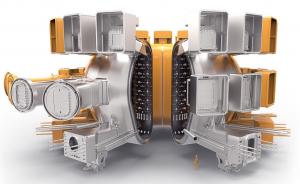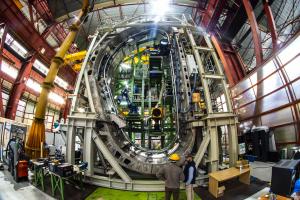Contract awarded to Spanish company
The ITER Organization has concluded a contract with the Spanish company ENSA (Equipos Nucleares SA) for the welding of the ITER vacuum vessel.
ENSA is no stranger to the vacuum vessel welding project; since 2012 the company has been working under a phased contract with the ITER Organization to first develop specific welding processes and tools and then to procure the equipment. Phase three of the project—the execution of the welding works—was awarded to the firm in October 2020 following an international competition based on a negotiated procedure.
This is the third major machine assembly contract after the TAC1 and TAC2 Tokamak Assembly Contracts were signed in 2019.
The scope of the new contract—called VVW2P, for Vacuum Vessel Welding Production Phase—covers the welding of 9 vacuum vessel sector sub-assemblies and 54 ports. (A sub-assembly is the unit formed by one 40-degree vacuum vessel sector, two toroidal field coils, and a 40-degree thermal shield sector.) The estimated duration of the contract is 57 months, with a targeted completion date of March 2025. ENSA estimates peak personnel needs on site at 150 people.
Work will take place inside of the restricted space of the Tokamak pit, as the sub-assemblies are successively lowered into place by the TAC-2 ITER Organization assembly contractor and attached to their supports. ENSA contractors will join and weld the vacuum vessel sectors according to a plan that aims to minimize deformation. The first sectors to be welded together in 2022 are sector #6 (already on sub-assembly tooling) and sector #7 (expected from Korea in August 2021).
ENSA will be supported by the Indian firm Larsen & Toubro as the sub-contractor for the welding of the major part of the ports.
The ENSA team will face a challenging task, evolving in a crowded tokamak pit environment with co-activity on every side. The weld robots will have access from inside the vessel only, as the thermal shield panels and the toroidal field coils block access to the vessel's outer shell. Weld thickness is consequential—up to 60 mm—and weld shrinkage will have to be managed at every step of the process to ensure the correct shape of the final vessel assembly. Finally, stringent volumetric examination protocols will be required to comply with French nuclear regulations.
"As a nuclear pressure vessel, the ITER vacuum vessel is subject to conformity assessments performed by a body authorized by the French Nuclear Regulator," explains Frantz de la Burgade, Group Leader for the Sector Modules Delivery & Assembly Division. "The technical documentation will have to be edited sufficiently in advance to allow enough time for this Agreed Notified Body to review."
During the initial phase of the contract (P0), which has been underway since the kick-off meeting in November 2020, the ENSA team is focusing on a selection of preparatory tasks, including documents, engineering tests, trials, qualification, and training.
"To perform a good weld is one thing; to be in a position to justify it has been perfectly done is an additional challenge," says De la Burgade. "The contractor is asked to predict shrinkage behaviour at each step of the assembly process, so that the expected shrinkage can be compensated by the relative pre-positioning of two consecutive sectors in the pit before the welding begins. Another important challenge of the initial phase of the contract is to mobilize experienced operators for both welding and non-destructive examination."
The early team, mobilizing to organize the preparatory activities on site, will be followed by increasing numbers of workers as the tasks begin in the ITER tokamak pit. A core team of experienced engineers from ENSA is already collaborating with the ITER engineering teams, as they familiarize themselves with the overall construction work packages and the engineering input required for the optimization of work execution.
A machining workshop is planned on site for the customization of splice plates—material used to ease the assembly of two consecutive sectors. The company will also dispose of space to install mockups from its facility in Santander, Spain, that had been used during the tool qualification process and that will now serve for the training of operators.



